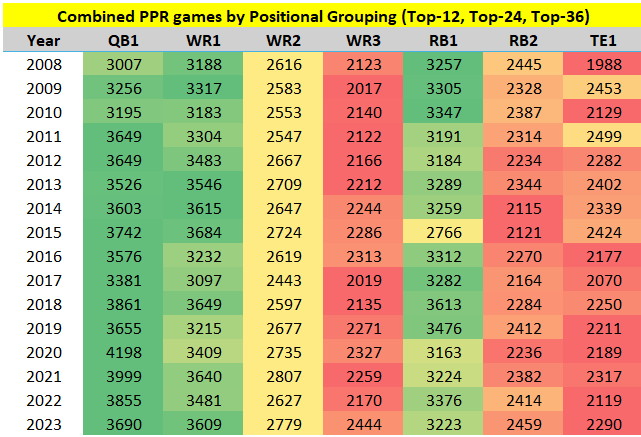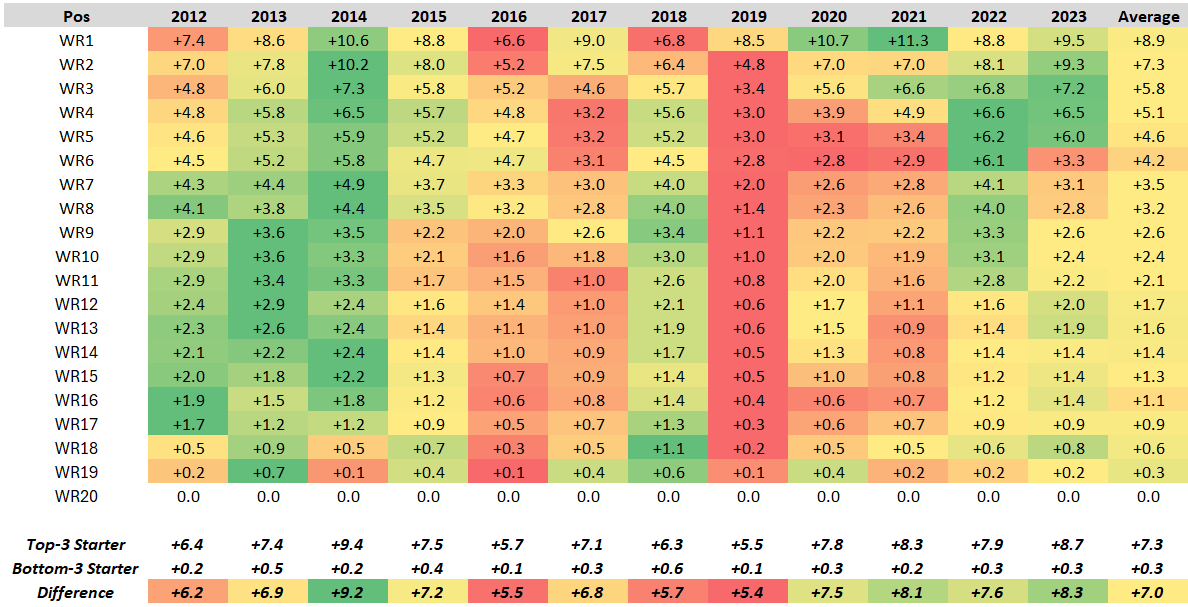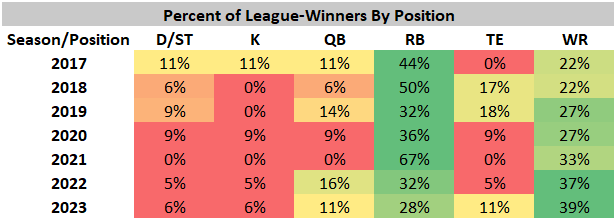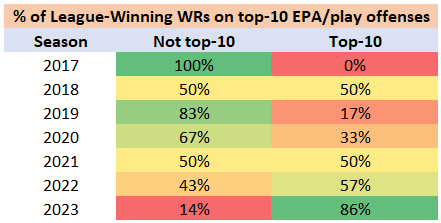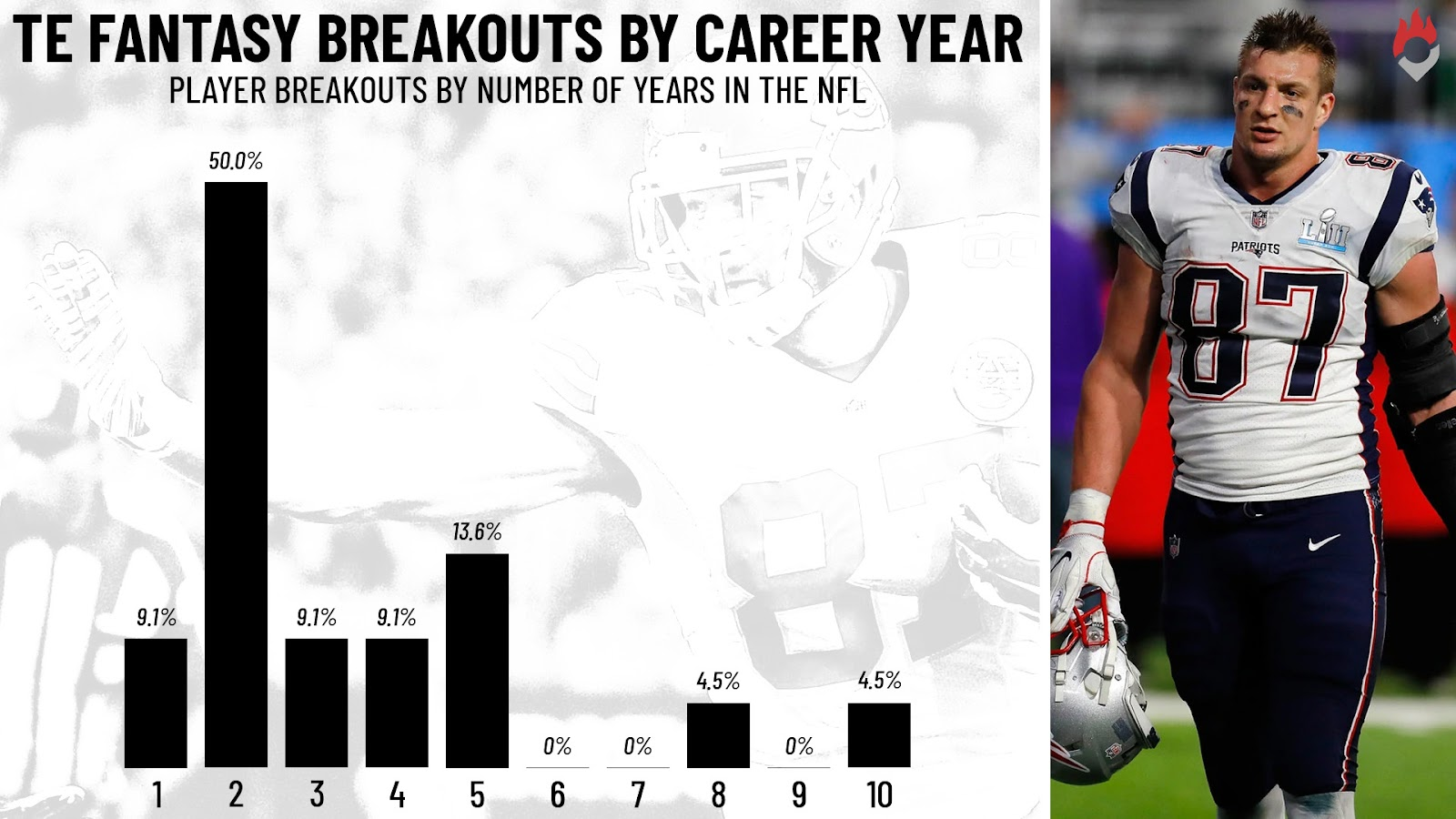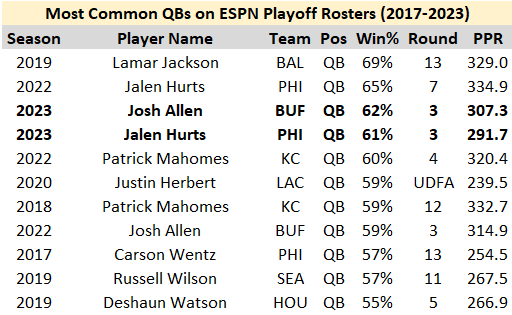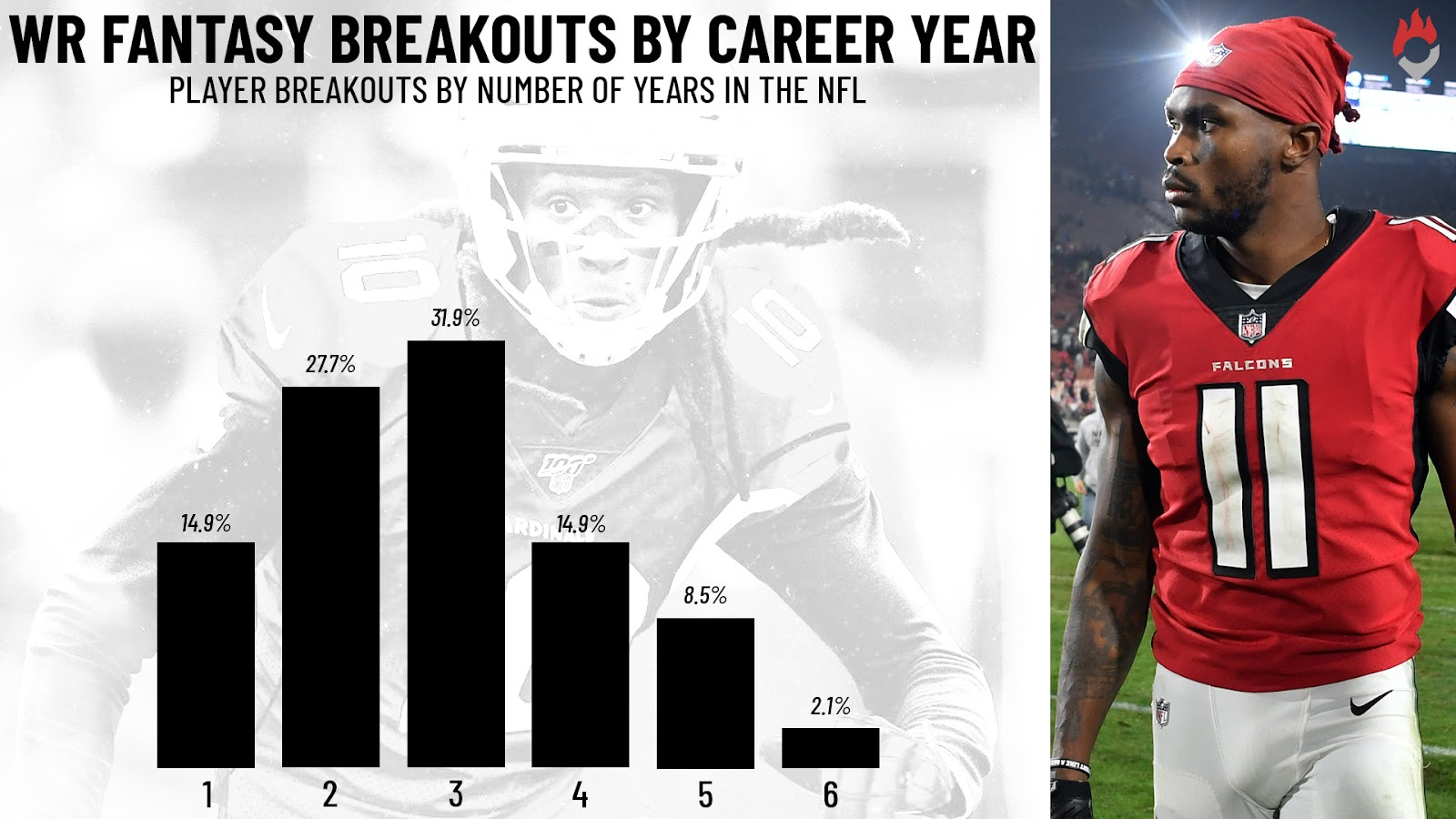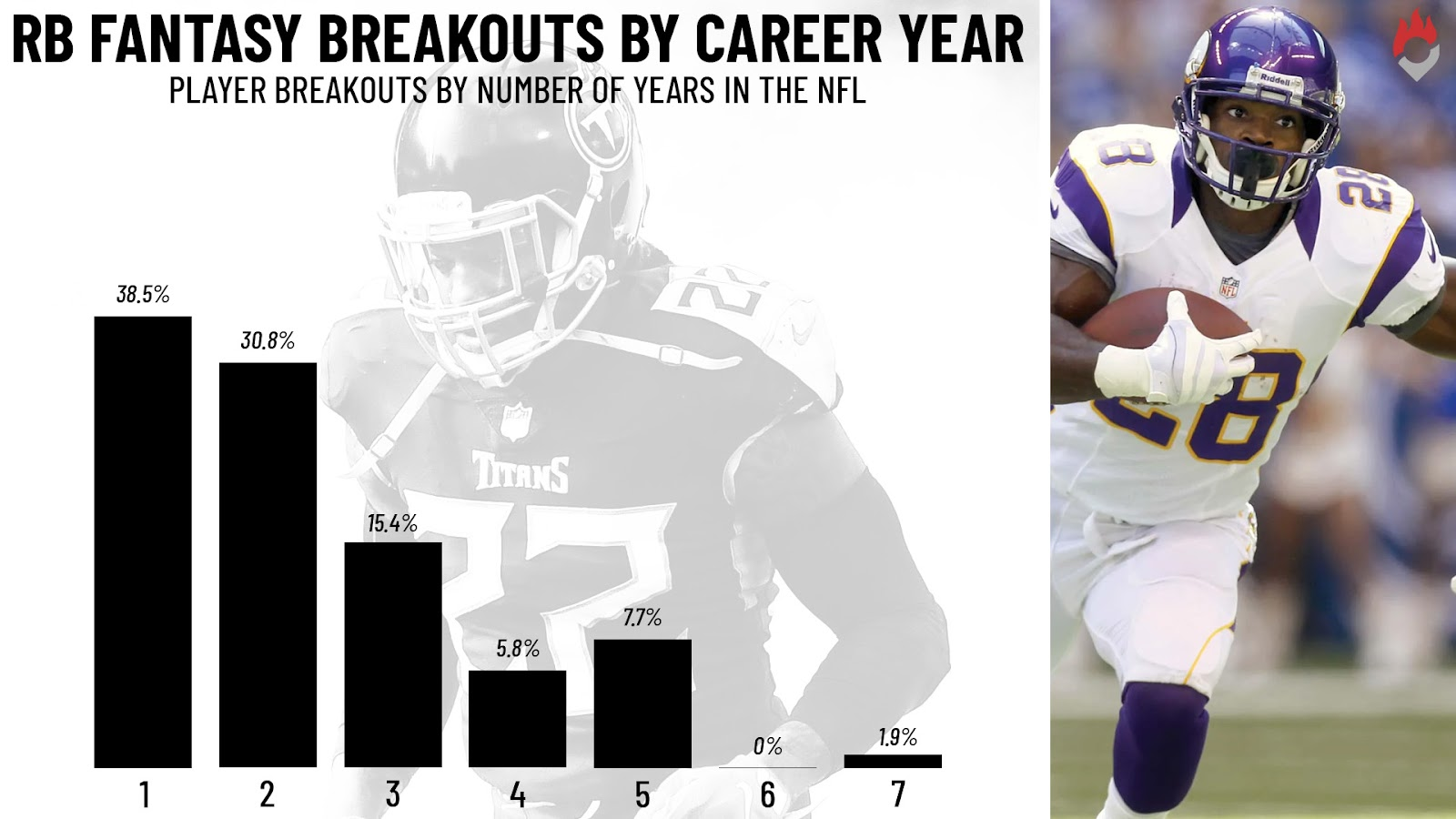There are two types of fantasy analysts:
One goes to great lengths to ignore and forget their own mistakes. They’ll victory-lap their wins for that sweet, sweet dopamine hit, but you won’t ever catch them owning their misses publicly.
The other incessantly thinks about and even openly discusses their failures. Not just as an exercise in self-flagellation but also as a way to force themselves to figure out exactly where they went wrong. And then, to try to learn from their mistakes and do better.
In other words, there are two types of fantasy analysts: bad ones and good ones.
Since I hope to join the ranks of the latter, that leaves only two motivations for a piece like the one you’re reading: a genuine desire to understand what exactly happened in the 2023 fantasy football season and a drive to improve next year’s results. So in this article, I’ll seek to accomplish both of those goals.
TL;DR
The RB position is in serious decline, with WRs becoming better upside bets early in drafts for multiple seasons in a row. That trend seems unlikely to reverse given the distributions and levels of talent at each position, reinforced by the 2024 draft class.
The TE landscape and optimal strategy will look very different if Travis Kelce is indeed past his prime, but a lot of usage and age-based trends are currently favoring the position as a whole.
Both early-round and late-round QB strategies are alive and well, especially if the QB you select is hyper-mobile.
A handful of play-callers produced a shockingly large portion of the fantasy-relevant players in 2023.
The market overreacted to rookie RBs joining backfields, and will likely do so again.
Running Backs
First, some groundwork. I view fantasy football as being ruled by a power-law distribution; only a small handful of players truly “matter” each year, in the sense that having them specifically on your roster dramatically increases your odds of winning your league. A good outcome-based way of measuring this is outlined in Anatomy of a League Winner, where any player appearing on a playoff team in over 55% of ESPN leagues was deemed a “league-winner.”
Within Anatomy, it is noted that RB is the most important and most valuable position in fantasy football, due to a combination of unmatched high-end scoring potential and positional scarcity. From 2017-2022, 17 of 31 (55%) league-winning RBs were drafted in the first three rounds.
That all changed in 2023. By looking at the positions that produced a “league-winner” in each round, we can observe that focusing on the RB position early worked if you drafted exactly Christian McCaffrey. Otherwise, you’d have been best off ignoring RBs entirely in favor of WRs and QBs until at least Round 4 (the other league-winning RBs in order of ADP were Travis Etienne, Alvin Kamara, Raheem Mostert, and Kyren Williams).
In the first figure, we notice that only one league-winning RB was drafted from Rounds 1-3 in 2023, compared to 17 over the past six seasons (an average of 2.8 per year).
Or, in other words, not only were just 20% of league-winning RBs selected in the first three rounds in 2023, but 100% of league-winning QBs and 71% of league-winning WRs went there as well. That compares to just 13% of league-winning QBs and 33% of league-winning WRs going in the first three rounds from 2017-2022.
Until last year, selecting RBs early was very clearly the optimal strategy. But if you used that strategy in 2023, you missed out on every league winner available from the early rounds outside of Christian McCaffrey. In this sense, 2023 was an extreme outlier season.
But calling 2023 an outlier is not to say we could not have seen this coming; in fact, ADP largely did. This year was only the second time over the past two decades in which WRs outnumbered RBs over the top 15 picks, and that wasn’t random. Before this year, 57% of all Rounds 1-3 league-winning WRs from the past six seasons had come in 2022, as well as the only Rounds 1-3 league-winning QB.
This is all to say that the slightly odd ADP trends (earlier WRs and QBs) that followed from the slightly odd results of the 2022 season — which we largely bet against continuing — accelerated rather than reverting to what we’d seen over the past several years.
2023 was an outlier, but in the ways we'd expect.
— Ryan Heath (@QBLRyan) January 4, 2024
Where you could draft league-winning players who ended up on ESPN playoff teams >55% of the time in 2023, vs. 2017-2022
The hot ADP trends this summer were earlier QBs, fewer early RBs, and more early WRs. All proved correct. pic.twitter.com/NctgGbxXAp
And 2022 was not the start of the RB position’s decline, either; whether we evaluate based on total aggregate fantasy points or Value Over Replacement, it’s clear that the position’s value has been diminishing for some time now.
Despite CMC's great season, 2023 was a below-average year to have a top-3 RB by Value Over Replacement.
— Ryan Heath (@QBLRyan) January 16, 2024
In fact, highest-end RBs have been losing value for a long time.
What do you think is the cause? pic.twitter.com/vR06fPo0T6
How can we explain the death of the high-end fantasy RB? There’s likely not a single answer, but from what I can tell, a decline in passing game usage at the position has a lot to do with it. As noted in Anatomy, from 2019-2022, 18 RBs earned at least 5.5 targets per game, an average of 4.5 players per season. However, only two players did so in 2022 (Austin Ekeler and Christian McCaffrey), while only one player did it in 2023 (Alvin Kamara).
Target volume is massively important to being a league-winning RB — targets are worth 2.5x as much as a carry in PPR leagues, and 15 of 34 league-winning RBs since 2017 (44%) have hit that 5.5 targets per game threshold. Yet targets are trending away from RBs over the past handful of seasons, making these league-winning seasons rarer.
But really, the reason why RBs are being targeted less league-wide comes down to talent. In 2017, a historically great RB draft class entered the league, providing mainstays like Christian McCaffrey, Joe Mixon, Dalvin Cook, Aaron Jones, Austin Ekeler, Alvin Kamara, James Conner, Kareem Hunt, and Leonard Fournette. As this group aged out of their peak seasons, targets and fantasy points at the position gradually fell, as did the VORP of top-3 RBs; in other words, high-end RBs now provide less value relative to a baseline starter.
What can we take away from this for 2024? For one, you should expect to have a harder time finding a true difference-making season from an RB than you have in the past. On the other hand, that means the positional scarcity is even greater, so hitting on one could be an even bigger advantage (McCaffrey was the single most common player on ESPN playoff rosters this year).
2023 saw a large portion of teams deploying a committee backfield*, with only two other recent seasons measuring up.
— Ryan Heath (@QBLRyan) February 5, 2024
*I defined a committee as multiple RBs on a team receiving 100+ carries, 10+ targets, and playing 12+ games. This is obviously imperfect pic.twitter.com/3nLfCgGKjd
If you do choose to go hunting for an RB in the early rounds of your draft, ensure he is capable of commanding massive target volume. Aside from Kamara, McCaffrey, and Ekeler, it was Breece Hall (5.3 targets per game), Bijan Robinson (4.9), and Jahmyr Gibbs (4.7) who came the closest to our 5.5 target per game benchmark. I’d expect this trio to be drafted very highly in 2024, but they’re the only new power-law RB candidates I can see.
Wide Receivers
WR-heavy drafters were rewarded in 2023 with the most valuable seasons we’ve seen from the top-5 since 2014. Having a top-3 starter at WR was more valuable than a top-3 starter at RB for the first time since 2015.
Moreover, the proportion of league-winning WRs (those on playoff rosters in over 55% of ESPN leagues) has steadily grown over the past several seasons. League-winning WRs have outnumbered RBs for two seasons in a row, despite that being “priced in” to ADP to some extent in 2023 — all but one of those 2023 league-winning WRs (Tyreek Hill, CeeDee Lamb, A.J. Brown, Amon-Ra St. Brown, Keenan Allen, and Stefon Diggs) went within the first five rounds, with Puka Nacua the only exception.
WRs beginning to dominate RBs in fantasy football has occurred in the face of NFL offenses collectively averaging just 6.50 yards per pass attempt (lowest of any season since 2008) in 2023, and sporting their lowest pass-to-run ratios over the past two seasons (1.22 and 1.25) since 2011. A greater proportion of yards and touchdowns have come on the ground than through the air over the past four seasons. If passing volume and efficiency are declining relative to running league-wide, why are WRs now better in fantasy football?
One clue is that overwhelmingly, league-winning WRs are now on efficient offenses. That might sound obvious, but it hasn’t always been the case — gone are the days of DeAndre Hopkins and Allen Robinson turning in top-5 finishes on horrific Texans and Jaguars teams.
Offenses with incredible WR talents are now largely able to leverage that into efficient overall play. NFL teams recognize the position’s importance, and have been successful when heavily investing in proven talent; just look at what Tyreek Hill has done for Miami’s offense, or what Stefon Diggs and A.J. Brown did for their respective offenses after being traded to new teams.
So even if receiving volume and production are down in the aggregate, elite WR talents are now more efficiently distributed on teams where they can best shine. This leads to both more league-winning WRs and more scarcity further down the ranks, propping up the position’s fantasy value even further.
The top-10 offenses by EPA/play in 2023 produced all but one league-winner* at the WR position
— Ryan Heath (@QBLRyan) January 22, 2024
*league-winner = on a playoff roster in >55% of ESPN leagues
Identifying the most efficient offenses is critically important to fantasy football success, and goes under-discussed. pic.twitter.com/n6YfOlTBWZ
Perhaps most importantly, the league’s overall WR talent is moving in the opposite direction of the RB position. The past several draft classes have been excellent, and 2024 is expected to be no different. The passing game becoming more important — especially at the college level — seems to have encouraged more of the best athletes to play QB or WR in their youth, when they used to play RB. As The Ringer’s Benjamin Solak has recently stated, “There will never be a bad WR draft again.”
As I noted in Age Curves, Year 1 accounted for just 7% of WR breakouts pre-2014 but 26% of breakouts since. Puka Nacua, Jayden Reed, Tank Dell, and Rashee Rice were all close to free in most leagues but made major impacts. So, in addition to focusing more on the WR position early in drafts, I’ll be stockpiling rookies with track records of production who go later in real life and fantasy.
Tight Ends
While the enduring wisdom at the TE position has long been to draft one early or to punt entirely in hopes of hitting on one late, that has largely worked due to the dominance of Travis Kelce in particular. Due to some combination of Kelce’s age, injuries, or dominant defense (which I’m sure we’ll litigate all off-season), his disappointing year left the position without any elite producers.
In terms of league winners, only T.J. Hockenson (Round 5) and Sam LaPorta (Round 17) qualified. There’s nothing especially noteworthy about the season’s best-performing highly-drafted TE being on lots of playoff teams, even if he was drafted a bit later than is typical for league-winners at the position.
A rookie league-winner is a bit of a surprise, but this (even pre-hindsight) historically talented and deep TE draft class would have been the season for it — I’m unsure this will apply to more typical years. It’s yet another reminder that many of the trends we identify are ultimately a result of talent profiles and that we should be willing to set those trends aside when there’s evidence the talent pool has changed. (Of course, that talented class entering Year 2 in 2024 should make us double down even harder on the trend below).
As usual, multiple waiver wire TEs were incredibly useful, including Year 2 breakouts from Trey McBride and Jake Ferguson, and a late season run from Isaiah Likely in which he averaged 14.4 FPG from Weeks 12-17. Of course, my infinite wisdom led me to tout the more expensive Greg Dulcich and Chigoziem Okonkwo instead, but I’d call that “right process, wrong players.”
Aside from the TE position not being overly important to get right during your draft (as we’ve always known based on them being league-winners much less frequently than RBs and WRs), the lesson here is to consider all players that a finding leads you to — not only the most expensive, trendy, or efficient ones. Give me Michael Mayer and Luke Musgrave or Tucker Kraft on every roster next year, I guess.
Which TEs have been best after the catch this year? Some may surprise you.
— Ryan Heath (@QBLRyan) January 17, 2024
Trey McBride taught me never to write off a TE with draft capital after Year 1, no matter how inefficient...
...so Michael Mayer will likely be a target of mine this offseason. pic.twitter.com/gHhujXb9wW
Quarterbacks
From 2017-2022, only one QB drafted in the first three rounds reached “league-winner” status (Josh Allen in 2022). In 2023, Allen and Jalen Hurts were the only two “league-winners” at the position, each going in Round 3.
What’s strange about this result is that Allen and Hurts both repeated as league winners, despite scoring fewer fantasy points and being more expensive to draft than the year prior. Neither had particularly special seasons by the high standards a Round 3 QB ought typically to be judged on, but each benefitted from the other top options at the position getting hurt or underperforming. VORP backs this view up, confirming that having the QB1 or QB2 this year conferred a below-average FPG advantage compared to prior seasons.
Then again, maybe it isn’t strange — the creator of the “late-round quarterback” strategy has long wrestled with its declining utility in the face of highly productive and predictable mobile QBs being drafted earlier and earlier each season — exactly what we’re observing now. Our own Jeff Henderson has been evangelizing early-round QBs for years (and especially 2023’s top league-winning QB, Josh Allen), as they are consistently big values by Wins Above Replacement.
Especially as loading up on RBs early on becomes less attractive, it could be even easier to select hyper-mobile QBs early in drafts. That doesn’t necessarily mean late-round QB is a dead strategy, though; the next-closest QB to league-winner status was C.J. Stroud, who made the playoffs in 54% of ESPN leagues at a Round 17 ADP.
Players like Dak Prescott, Jordan Love, and Brock Purdy outproduced the players drafted as QB1s but who were not hyper-mobile — all of Patrick Mahomes, Justin Herbert, Joe Burrow, and Trevor Lawrence proved to be fragile preseason projections, as their pass-catchers missing time or disappointing had a much greater effect on their fantasy output than a hyper-mobile QB like Lamar Jackson dealt with.
Hypothesis: Hyper-mobile QBs are less affected by the loss of a pass-catcher.
— Ryan Heath (@QBLRyan) February 6, 2024
(Because less of their fantasy production relies on making plays through the air)
Justin Herbert with Mike Williams: 24.1 FPG
Without: 17.0 FPG
CJ Stroud with Tank Dell: 21.2 FPG
Without: 13.1
(1/4)
The late-round QB strategy seems most viable when one either cannot get a hyper-mobile QB early or when a hyper-mobile QB is available late, as we might see with Kyler Murray, Anthony Richardson, or even Jayden Daniels in 2024.
Backpedaling to Stroud, he demonstrated an important point this season about rookie QBs, who are not competent fantasy producers and even hurt the production of their teammates on average, but who also create “Upside Wins Championships” scenarios. Nico Collins and Tank Dell had rock-bottom ADPs last summer, largely because the public perceived little upside for them in a potentially crowded WR corps on a bad team.
In reality, the combination of a rookie QB and a new play-caller should cause us to view an offense as an entirely new creation, about which we have no reliable information. When that intersects with late ADPs that imply certainty, I will be making it a point to target the skill position players on those offenses going forward. The entire team can be massively undervalued in drafts based on one incorrect (even if statistically likely) assumption about the QB’s ability.
Assuming rookie QBs go off the board on each of the first three picks this April, taking discounts on Chicago, Washington, and New England pass catchers late in drafts could prove sharp, even if most bust — because most late-round picks bust anyway, and Upside Wins Championships.
Miscellaneous Takeaways
I have a lot of other thoughts regarding Scott Barrett’s and my own good and bad takes. None of them cleanly fit the overall story I attempted to weave above, so forgive me for dumping them all here in a somewhat lazy and disjointed fashion.
We liked most of the league-winning WRs who went in the early rounds (with Keenan Allen and Amon-Ra St. Brown as especially big hits), but both Scott and I were too low on top-4 league winner CeeDee Lamb (and Dak Prescott by extension) due to the thought Mike McCarthy would bring the offense in a more run-heavy direction – after all, he told us, this was exactly why he fired OC Kellen Moore.
However, McCarthy’s offenses have always aired it out, including posting a +6% pass rate over expectation during his final three years in Green Bay. Fixating on a single quote made in March was an obvious mistake here.
Year 2 WRs largely did not pay off their draft costs this year, a tough look for someone who feverishly touted Garrett Wilson and Drake London, idiotically came around on Treylon Burks and Jahan Dotson, and — most embarrassingly — put Christian Watson’s name in his Twitter bio.
I won't beat myself up regarding Wilson considering his QB — an important component of the thesis for his improved efficiency — was taken out of the picture minutes into the season. Burks and Dotson are cautionary tales for those having fun with splits; as I’ve noted, you can make most rookie WRs look good if you zero in on the second half of the season. Full-season statistics are more useful than partial-season statistics.
Aside from taking aggressive stances on platforms like Underdog (where they got quite expensive compared to most normal redraft leagues), I have no regrets about touting profiles like London’s and Watson's, and I will do it again with similar ones in the future.
Most WRs entering Year 2 will not see their target share plummet from nearly 28% down to 22% as London’s did — part of a list of transgressions for which his coach was ultimately fired — and the Falcons averaged 28% more pass attempts per game than in 2022, as I more or less predicted.
Watson’s QB play turned out to be much better than expected, but we learned he’d injured his hamstring after practically everyone had drafted, the same hamstring that ended his season just as he seemed to be getting in sync with Jordan Love.
The same “September surprise” injuries also took out two of Scott Barrett's favorites — Cooper Kupp and Darren Waller. Waller was additionally stuck on a passing game unable to support much fantasy relevance, a cautionary tale we often forget. Injuries to both Waller and Daniel Jones aside, the team committing to Jones despite little improvement as a passer should have been a massive red flag.
Speaking of injured QBs, Anthony Richardson was shaping up to be a massive hit, averaging an incredible 0.76 fantasy points per dropback (would have easily been QB1 this year) and 29.2 fantasy points per four quarters (to Josh Allen’s 24.4 FPG). He was easy to forget after a long season but may have been the most painful instance of “good process, bad results” this year.
An unreported Jeff Wilson injury made it a lot harder than it should have been to get on board with Raheem Mostert and De’Von Achane as well — though considering how proficient we knew Mike McDaniel’s running game could be whenever a speedy player is plugged into it (going back to when McDaniel was Kyle Shanahan’s run game coordinator), we absolutely should have emphasized the backfield more.
On the point about the Shanahan/McVay (or really, the Mike Shanahan) coaching tree, across four teams (the 49ers, Texans, Dolphins, and Rams), it produced the WR2, WR6, WR7, WR13, WR16, WR19, WR22, and WR24 by FPG; a third of the league’s top-24 WRs. Three of those offenses also gave us the RB1, RB2, RB4, and RB5. Wherever there is potential opportunity available on these rosters — and also, the Packers under Matt LaFleur as their young skill position core improves, and now the Falcons with McVay disciple Zac Robinson installed as OC — fantasy managers should take notice.
Puka Nacua and Kyren Williams were players we missed despite McVay’s and Matthew Stafford’s histories of supplying excellent volume to RBs and WRs. Each was obscured by Kupp and by McVay lying to us about Cam Akers, but you luckily still had a chance to grab them on waivers after Week 1 — arguably the two most pivotal moves you could have made this year.
I think the lesson here is to just take a McVay running back in every 2024 draft, regardless of which one he tells you to https://t.co/dIJprTmpGq
— Ryan Heath (@QBLRyan) January 3, 2024
In contrast to Williams, we expected James Conner to be a bell cow, and he delivered down the stretch; he was the overall RB1 averaging 23.9 FPG from Weeks 13-18. The Keenan Allen call was similar; he’d just seen so much more volume over his career than his ADP implied, and it proved to be sticky. Expecting older players to maintain elite workloads can be a dangerous game, but the market pricing in that risk in the case of these two tipped the calculation in favor of the potential reward.
Speaking of age, I’d consider the Age Curves analysis a moderate success at the RB position. Years 1 and 2 were notably the most common breakout seasons for RBs, and no fewer than seven such players finished top-30 in fantasy Wins Above Replacement (WAR). Bijan Robinson, Jahmyr Gibbs, and Breece Hall had their breakout potentials priced in, while Kyren Williams, Rachaad White, Isiah Pacheco, and James Cook rounded out the group, with Williams finishing top-4 in WAR and achieving league-winner status. All seven, aside from Robinson, were values at ADP.
Fantasy managers largely worried too much about rookie RBs drafted on Day 2 and Day 3 — none of Zach Charbonnet, Tyjae Spears, Tank Bigsby, or Kendre Miller made particularly big impacts, and over-focusing on them caused many to miss on Alvin Kamara and Travis Etienne.
It never feels good to watch a team with an established starter spend Day 2 draft capital on another RB, but the market adequately prices in that risk now due to how traumatized we’ve all been in the past. With another mediocre RB class on tap for 2024, I’ll be looking to take advantage of any value created if teams like the Rams, Chiefs, or Buccaneers add to their backfields.
Finally, QB injuries had an outsized impact on players at all positions in 2023. Though the total number of different QB starters or games missed wasn’t massively out of line with recent history, six very fantasy-relevant QBs (Joe Burrow, Kirk Cousins, Anthony Richardson, Deshaun Watson, Daniel Jones, and Aaron Rodgers) missed a whopping combined 67 games.
Slowly digging into the NFL injury data for 2023
— Edwin Porras, DPT (@FBInjuryDoc) January 30, 2024
Starting QBs missed 102 total games due to injury
in 2022 that number was 88
These guys skewed the numbers missing a combined 67 (!) games due to injury
Burrow
Cousins
Daniel Jones
Deshaun Watson
Ant Richardson
Aaron Rodgers pic.twitter.com/gjLlQ80FeR
Richardson and Jones were hyper-mobile late-round QB favorites, while the other four left their respective offenses for dead. Imagine the seasons Breece Hall and Garrett Wilson, Justin Jefferson, Jordan Addison, and T.J. Hockenson, Tee Higgins and Ja’Marr Chase, and Amari Cooper could have had if afforded a healthy signal-caller for all 17 games (or, in Cooper’s case, if he could have just had Joe Flacco all season). With any luck, injuries to QBs will not be so brutally concentrated in 2024.




